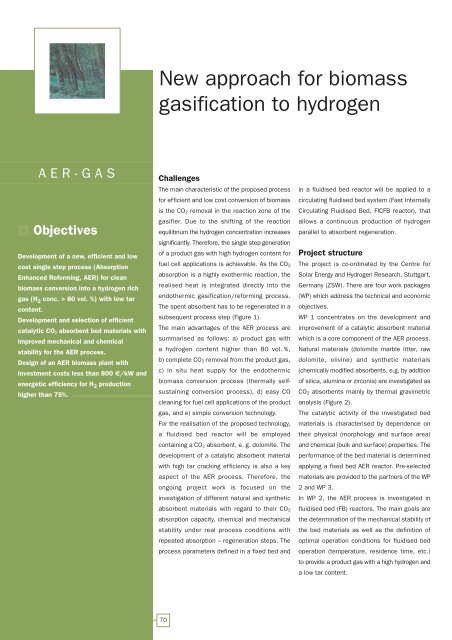European Bio-Energy Projects
European Bio-Energy Projects
European Bio-Energy Projects
You also want an ePaper? Increase the reach of your titles
YUMPU automatically turns print PDFs into web optimized ePapers that Google loves.
AER-GAS<br />
Objectives<br />
Development of a new, efficient and low<br />
cost single step process (Absorption<br />
Enhanced Reforming, AER) for clean<br />
biomass conversion into a hydrogen rich<br />
gas (H2 conc. > 80 vol. %) with low tar<br />
content.<br />
Development and selection of efficient<br />
catalytic CO2 absorbent bed materials with<br />
improved mechanical and chemical<br />
stability for the AER process.<br />
Design of an AER biomass plant with<br />
investment costs less than 800 €/kW and<br />
energetic efficiency for H2 production<br />
higher than 75%.<br />
New approach for biomass<br />
gasification to hydrogen<br />
Challenges<br />
The main characteristic of the proposed process<br />
for efficient and low cost conversion of biomass<br />
is the CO2 removal in the reaction zone of the<br />
gasifier. Due to the shifting of the reaction<br />
equilibrium the hydrogen concentration increases<br />
significantly. Therefore, the single step generation<br />
of a product gas with high hydrogen content for<br />
fuel cell applications is achievable. As the CO2<br />
absorption is a highly exothermic reaction, the<br />
realised heat is integrated directly into the<br />
endothermic gasification/reforming process.<br />
The spent absorbent has to be regenerated in a<br />
subsequent process step (Figure 1).<br />
The main advantages of the AER process are<br />
summarised as follows: a) product gas with<br />
a hydrogen content higher than 80 vol. %,<br />
b) complete CO2 removal from the product gas,<br />
c) in situ heat supply for the endothermic<br />
biomass conversion process (thermally selfsustaining<br />
conversion process), d) easy CO<br />
cleaning for fuel cell applications of the product<br />
gas, and e) simple conversion technology.<br />
For the realisation of the proposed technology,<br />
a fluidised bed reactor will be employed<br />
containing a CO2 absorbent, e. g. dolomite. The<br />
development of a catalytic absorbent material<br />
with high tar cracking efficiency is also a key<br />
aspect of the AER process. Therefore, the<br />
ongoing project work is focused on the<br />
investigation of different natural and synthetic<br />
absorbent materials with regard to their CO2<br />
absorption capacity, chemical and mechanical<br />
stability under real process conditions with<br />
repeated absorption – regeneration steps. The<br />
process parameters defined in a fixed bed and<br />
70<br />
in a fluidised bed reactor will be applied to a<br />
circulating fluidised bed system (Fast Internally<br />
Circulating Fluidised Bed, FICFB reactor), that<br />
allows a continuous production of hydrogen<br />
parallel to absorbent regeneration.<br />
Project structure<br />
The project is co-ordinated by the Centre for<br />
Solar <strong>Energy</strong> and Hydrogen Research, Stuttgart,<br />
Germany (ZSW). There are four work packages<br />
(WP) which address the technical and economic<br />
objectives.<br />
WP 1 concentrates on the development and<br />
improvement of a catalytic absorbent material<br />
which is a core component of the AER process.<br />
Natural materials (dolomite marble litter, raw<br />
dolomite, olivine) and synthetic materials<br />
(chemically modified absorbents, e.g. by addition<br />
of silica, alumina or zirconia) are investigated as<br />
CO2 absorbents mainly by thermal gravimetric<br />
analysis (Figure 2).<br />
The catalytic activity of the investigated bed<br />
materials is characterised by dependence on<br />
their physical (morphology and surface area)<br />
and chemical (bulk and surface) properties. The<br />
performance of the bed material is determined<br />
applying a fixed bed AER reactor. Pre-selected<br />
materials are provided to the partners of the WP<br />
2 and WP 3.<br />
In WP 2, the AER process is investigated in<br />
fluidised bed (FB) reactors. The main goals are<br />
the determination of the mechanical stability of<br />
the bed materials as well as the definition of<br />
optimal operation conditions for fluidised bed<br />
operation (temperature, residence time, etc.)<br />
to provide a product gas with a high hydrogen and<br />
a low tar content.

















